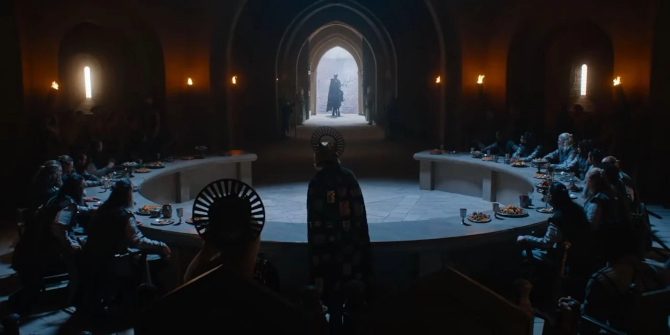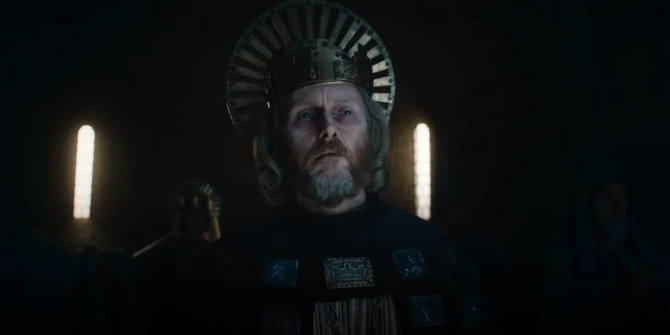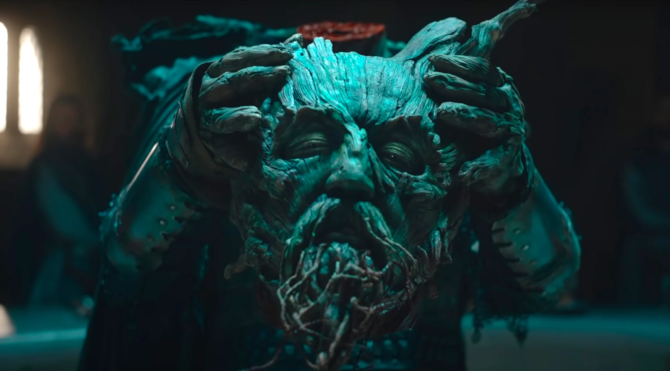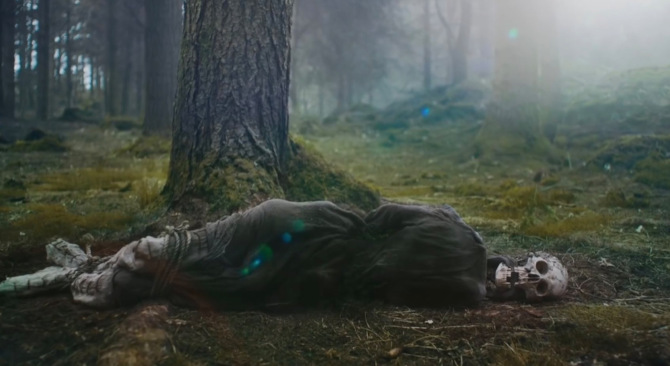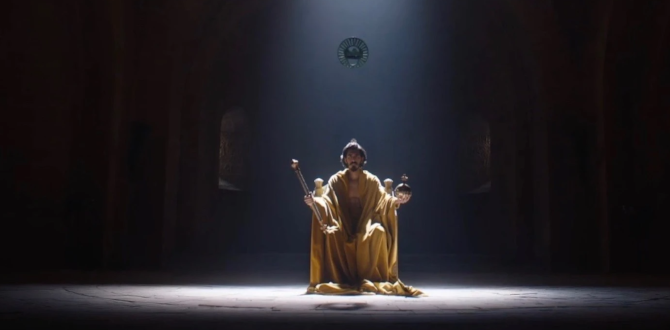The Lady: “Red is the color of lust, but green is what lust leaves behind, in heart, in womb. Green is what is left when ardor fades, when passion dies, when we die, too.”
Fabled reverberations of distant past, a time when magic still filled the air. . . and men would quest to prove their knightly virtues, are brought to vivid life in writer/director David Lowery’s 2021 Arthurian era legend, The Green Knight.
Almost ethereal in its nature – not due to some sort of fragility, but rather because it feels as if it is transcendent of this time. . . a wisp of lore echoing from distant past that ought be lost at the merest blink of an eye, it is akin to being transported back into a magic-tinged Medieval landscape. Lowery deserves much credit for brewing such a mythical auratic atmosphere. It is no easy feat being an Arthurian laureate, for you must know the earliest records dating back to Geoffrey of Monmouth in the twelfth century, through the long annals. . . from Chrétien de Troyes, Wolfram von Eschenbach and Thomas Malory (a lot of these early works having been translated from Middle English), to a much more recent work of Mark Twain. . . and that is not even including the very document that this story is based on – written by some unknown scribe sometime in the fourteenth century. Though Lowery makes many changes adapting “Sir Gawain and the Green Knight”, it is grand praise to say that this is the first film since John Boorman’s Excalibur (1981) to capture some true semblance (or perhaps essence) of these original source materials.
The Age is Dark, the world foreboding – paganism still a thorn in the side of Christianity (which is much closer to its infancy here), light barely penetrating into this weary world – echoed by an aged, failing King Arthur (Sean Harris) and wife Guinevere (Kate Dickie). . . his weakened state can be felt outside the castle walls, for his kingdom is no longer at blissful peace. The flaws of unjust men place an unyielding weight upon their very own shoulders. . . for a knight must live up to a chivalric code that goes hand in hand with being a good Christian.
This is the very situation young Gawain (Dev Patel) finds himself in. With no epic stories to tell, he is name only for being related to the royal family. . . in this iteration, a nephew to the King. His Mother (Sarita Choudhury), implied to be Morgan le Fay (also known as Morgana), worries for him. . . as he spends more time at brothels, exclusively with Essel (Alicia Vikander), than doing anything remotely knightly.
That is until Christmas day, when a foreboding Green Knight (Ralph Ineson) makes his presence felt at court. Part man, part nature (wooden visage and branches growing from his mossy armour), he delivers a letter to the Round Table. . . offering a challenge of ‘game’ to anyone brave enough to face him. More like mind games, the rules state that if any single blow connects he will give up his axe, though his foe then must travel to the Green Chapel a year henceforth to receive an equal blow in return.
Hesitant, Arthur’s knights balk at the bargain, though Gawain, seeing his chance at chivalric conquest, accepts. . . a decision that will not only forever bond him with this haunting presence, but also place him in a year long battle with himself – will he be able to elevate to an idealistic knightly standard?
In all ways a story of human beings themselves, Gawain is a stand-in for all of us. Along his journey, he will be faced with challenges revolving around the five knightly virtues, namely: generosity, courtesy, friendship, chastity, and piety. Often failing miserably, he is too haughty, selfish, suspicious, immoral, and of utter unbelief to be on such a quest. Yet, he does have some form of perseverance, for even though he looks to turn back several times, he continues on his course. . . along the way, meeting a Scavenger (Barry Keoghan), a friendly fox, a spirit named Winifred (Erin Kellyman), as well as a Lord (Joel Edgerton) and his Lady (Alicia Vikander once again – another form of test for the would-be knight). All of this leads to the real question – will Gawain find the integrity of self to Perceval, I mean persevere – a little Arthurian wordplay never hurt anyone.
Trotting at its own unique pace, some modern viewers will find it rather slow, yet you must remember that this is an epic quest that will take six long days afoot (and on horseback) to achieve. It is a journey of both mind and soul, and whether those two very different things can be unified by journey’s end. For in our mind, there is doubt, incredulity, and endless questions, while the soul brings inner peace, purity, and divinity. Something as small as a flinch can be proof that you have not achieved your mission in life.
As rich in layers, themes and meaning as the very text it is based upon, there will be plenty of theorizing on a number of worthy questions – ‘is Morgan le Fay using her magic for good or evil?’, ‘what exactly does the Green Knight symbolize – could it be symbolic of a return to nature or perhaps a virtue tester of knights?’, and ‘which of the three endings (in all of its open-endedness) do we believe to be the true conclusion?’. Perhaps the beauty of this work is that each and every one of us will come to our own unique answers depending on the path we have followed to get where we are in life today.
A movie of visual splendor fused with thought-provoking nature, The Green Knight is cinema incarnate. Shot on location in Ireland, and etched with stony greys, menacing blacks and brilliant flashes of light. . . we must not forget the importance of the colour green in all of this. Matched by solid acting, a stellar script, intriguing period style music by Daniel Hart (the sound design is also noteworthy), and masterful editing (also done by Lowery), it is a perfect example of every layer working in unison to create a very special hypnotic motion picture. Lastly, it is worth noting that famed “The Lord of the Rings” author J.R.R. Tolkien deserves much credit for the modern popularity of this story – for he released a scholarly edition of the tale along with E.V. Gordon back in 1925, which significantly advanced readership. . . he would later translate the text himself as well. So, stay ahead of the crowd and explore this astonishing Arthurian vision. . . your cinephile friends will be green with envy.


